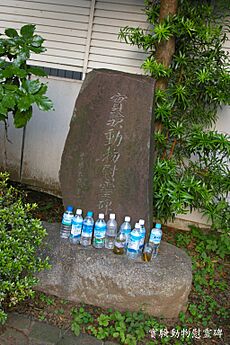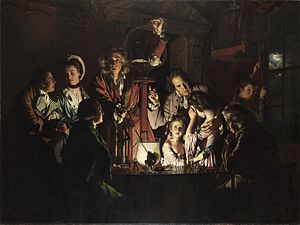Animal testing facts for kids
Quick facts for kids 
A Wistar laboratory rat
|
|
| Description | Around 50–100 million vertebrate animals are used in experiments annually. |
|---|---|
| Subjects | Animal testing, science, medicine, animal welfare, animal rights, ethics |
Animal testing means using animals for scientific experiments. It's also called animal experimentation or animal research. Animals like fruit flies and mice are often used. Every year, about 50 to 100 million animals with backbones (like mammals, birds, fish) and many more animals without backbones (like insects) are used worldwide.
Most animals used for these experiments are specially raised for this purpose. But some might be caught from the wild or bought from places that get them from animal shelters.
These experiments happen in many places, such as universities, medical schools, farms, and large companies. People who support animal testing say that animals have helped with almost every medical discovery in the last 100 years. They argue that even advanced computers can't fully show how different parts of a living thing (like molecules, cells, organs) work together.
However, some scientists and groups like PETA disagree. They believe animal testing is cruel, not always done well, and expensive. Others argue that animals have a right not to be used for experiments. They also say that what happens in animals might not be the same in humans. Rules about animal testing are different in various countries.
Contents
What is Animal Testing?
The words animal testing, animal experimentation, and animal research all mean similar things. Another word, vivisection, used to mean cutting into live animals for experiments. Today, some people use "vivisection" to mean any experiment on living animals, especially those who are against it. This word often makes people think of suffering. Scientists usually prefer the term "animal experimentation."
A Brief History of Animal Testing
People have used animals for experiments for a very long time. The first records are from Greek writings around 200 to 400 years before Christ. Aristotle and Erasistratus were some of the first to experiment on living animals. Later, Galen, a doctor in ancient Rome, dissected pigs and goats. An Arabic doctor named Avenzoar, in 12th-century Spain, tried out surgical methods on animals before using them on humans.
Animals have played a big part in scientific discoveries throughout history:
- In the 1880s, Louis Pasteur showed his germ theory by giving anthrax to sheep.
- In the 1890s, Ivan Pavlov famously used dogs to study how they learn (called classical conditioning).
- On November 3, 1957, a Russian dog named Laika became the first animal to orbit the Earth.
- In the 1970s, antibiotic treatments and vaccines for leprosy were developed using armadillos.
- In 1974, Rudolf Jaenisch created the first genetically changed mammal. He put virus DNA into the genes of mice.
- In 1996, Dolly the sheep was born. She was the first cloned mammal.
In the 20th century, testing how harmful substances are (called toxicology testing) became very important. Before 1937, laws about drugs were not very strict. Drugs didn't have to be checked for safety. But in 1937, a drug called Elixir Sulfanilamide caused more than 100 deaths. It led to severe pain and sickness. After this, the U.S. Congress made laws saying that drugs must be tested on animals before they could be sold. Other countries soon made similar laws.
Even hundreds of years ago, people had different opinions about animal testing. Some believed animals were not as important as humans. Others thought animals were too different from humans, so results from animal tests wouldn't apply to people.
Supporters of animal testing argued that these experiments were needed to gain knowledge. Claude Bernard, a famous scientist, wrote in 1865 that understanding life requires going through a "long and ghastly kitchen" of experiments. He said that experiments on animals were "entirely conclusive" for human health and safety. Because of Bernard, animal testing became a common scientific method. Interestingly, his wife, Marie Françoise Martin, started the first group against vivisection in France in 1883.
Public attention to this debate grew during the brown dog affair in the early 1900s. In this event, medical students and people against animal testing argued with police over a memorial for a dog used in experiments.
Rules and Laws for Animal Testing
Rules for animals in laboratories are different depending on the animal. In the U.S., under the Animal Welfare Act, any experiment can be done on an animal if scientists can show it's important for science. Researchers must talk with a veterinarian and a special committee called the Institutional Animal Care and Use Committee (IACUC). Every research place must have an IACUC.
The IACUC makes sure that:
- Other ways to do the research (like using non-animal methods) have been considered.
- Experiments are not repeated unnecessarily.
- Pain relief is given to animals unless it would stop the study from working.
These committees oversee all animals with backbones used in testing at places that get money from the U.S. government. Even though the Animal Welfare Act doesn't specifically mention mice and birds raised for research, these animals are still protected under other rules that the IACUCs follow.
The Three Rs of Animal Research
The Three Rs (3Rs) are important guidelines for using animals in research in a more ethical way. W.M.S. Russell and R.L. Burch first described these in 1959. The 3Rs are:
- Replacement: This means using methods that don't involve animals whenever possible. For example, using computer models instead of live animals.
- Reduction: This means finding ways to get the same amount of information from fewer animals. Or, getting more information from the same number of animals.
- Refinement: This means making sure animals feel as little pain or stress as possible. It also means making their lives better during experiments. This includes using methods that are not invasive (don't involve cutting into the animal).
The 3Rs aim to improve animal welfare and the quality of science when animal use can't be avoided. Many countries around the world now follow these 3Rs, and they are part of many laws and rules.
Even with the 3Rs, some countries like Canada, Australia, and Germany have reported using more animals for experiments recently. They are using more mice and fish, but fewer cats, dogs, monkeys, rabbits, guinea pigs, and hamsters.
How Many Animals Are Used?
It's hard to get exact numbers for animal testing worldwide. However, it's thought that about 50 to 100 million animals with backbones are used in experiments each year. This includes about 10 to 11 million in the European Union. These numbers do not include animals without backbones, like shrimp and fruit flies, which are also used.
Ethical Questions
People have different ideas about whether it is right to use animals for experiments.

Some people, like the British Royal Society, argue that animal research has been essential for almost every major medical discovery in the last century. They believe that complex interactions in living bodies cannot always be replicated by computer models alone.
Others, including some animal welfare groups, question the need for animal research. They argue that it can be unfair to animals, that some tests are outdated, or that animal models don't always accurately predict effects in humans. They also believe animals have a right not to be used or harmed in experiments.
Governments in places like the Netherlands and New Zealand have banned certain invasive experiments on great apes. In 2015, captive chimpanzees in the U.S. were added to the Endangered Species Act, making it harder to experiment on them. Many medical schools and agencies in countries like China and Japan have built monuments and hold services to honor animals used in research.
Historically, the debate has been ongoing. In the 17th century, some argued that pain could affect research results. Others, like Claude Bernard, a famous physiologist, argued that animal experiments were necessary for scientific progress. Early animal protection laws, like the British Cruelty to Animals Act 1876, were created to regulate animal testing.
Finding New Ways: Alternatives to Animal Research
Scientists and governments are actively looking for and developing alternatives to animal testing.
Researchers at Harvard's Wyss Institute have created "organs-on-a-chip." These tiny devices contain human cells in a 3D system that mimics real human organs, like a "lung-on-a-chip." These chips can be used for disease research, drug testing, and safety checks instead of animals. Scientists are also using 3D bioprinters to create human tissues for lab tests.
Another alternative is in silico research, which uses computer simulations and mathematical models. This helps predict how drugs and chemicals might affect humans without using animals. Microdosing is another method where volunteers receive tiny, safe doses of a test compound. This helps researchers learn about drug effects early on. Other methods include positron emission tomography (PET) scans to study the human brain and epidemiological studies that look at disease patterns in human populations.
Many official groups, like the European Centre for the Validation of Alternative Test Methods, work to promote and approve these new methods. Academic centers, such as the Center for Alternatives to Animal Testing at Johns Hopkins University, also research and develop alternatives.
Images for kids
-
Claude Bernard, a famous scientist, believed experiments on animals were important for human health.
-
One of Pavlov's dogs with a special tube to collect saliva. Pavlov studied how dogs learn.
-
Fruit flies are small insects often used in animal testing.
-
Enos, a chimpanzee, before his space flight in 1961. He was the third primate to orbit Earth.
-
Zebrafish are small fish used in labs, often for cancer research.
-
Dolly the sheep: the first mammal to be cloned from an adult cell.
See also
 In Spanish: Experimentación con animales para niños
In Spanish: Experimentación con animales para niños











